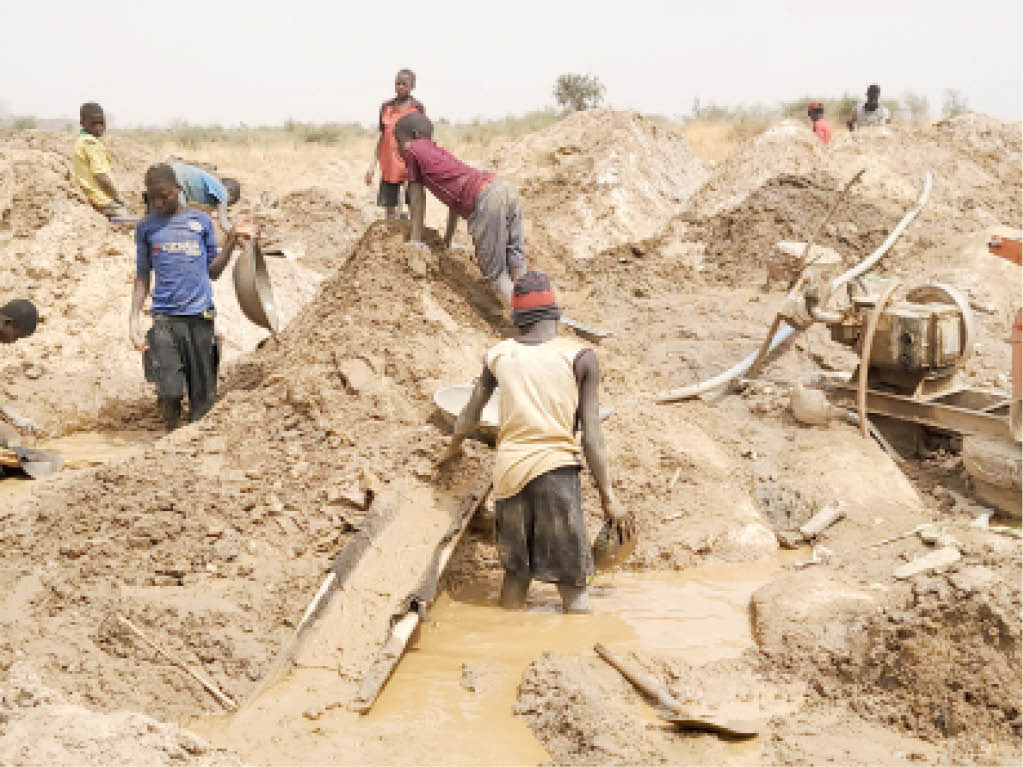Nigeria’s $5m from gold, mirror on mining sector leakage
A proud minister of solid minerals development, Dele Alake, had the honour of presenting to President Bola Tinubu Nigeria’s gold bars, produced through the efforts of our artisanal and small-scale miners. The Solid Minerals Development Fund refined the gold. Putting these two facts together, we get a picture of the possibilities that have remained hidden or […]

FILE PHOTO: Young men searching for gold from the paste of excavated sand
A proud minister of solid minerals development, Dele Alake, had the honour of presenting to President Bola Tinubu Nigeria’s gold bars, produced through the efforts of our artisanal and small-scale miners. The Solid Minerals Development Fund refined the gold. Putting these two facts together, we get a picture of the possibilities that have remained hidden or elusive for so long, yet are easily within our reach.
In the mining world, the day of the first pour of the viscous, molten gold into the receptacle with the shape of a gold bar is usually a day of celebration. As he presented the gold bars to the President, Alake could have said in his mind, to quote Bambulu in This is Our Chance, that “This is the product of my brain, the materialisation of my inventive genius”. Certainly, maximising the benefits of Nigeria’s extractive industry requires a fresh approach, different from the model that has been applied to it so far. That model has been defined by policy incoherence and lack of focus.
In summary, the missing link in the mining sector has been good management or leadership; and that could have been taken care of by the establishment of the right legal and operational frameworks that recognised the rights of these small-scale miners.
The Solid Minerals Development Fund was established in 2017 with a take-off fund of N30 billion. Seven years later, we are being told that the system has produced results. Why couldn’t the establishment of the Fund produce tangible results before now? So far, artisanal miners have dominated our mining scene, with no tangible results to the economy, except the wanton degradation of the environment and rising cases of sicknesses caused by the unhealthy practices. Indeed, one of the things that have been missing is an effective mechanism to link the miners with a fund or an enabler that would help them operate in an organised structure. The other is a structure or framework within which they can be regulated for results.
- NIGERIA DAILY: The Blueprint For Peace And Security In The Northwest
- Bandits levy Benue community N20m
The challenge of artisanal mining is almost a universal phenomenon in all nations endowed with solid minerals. Yet countries that have achieved success in this sector have found ways around the problem by turning the challenge into an opportunity. The measures adopted by or being advocated for these countries have been detailed in the World Bank’s report, 2023 State of the Artisanal and Small-Scale Mining Sector.
Citing a 2014 study by G. Hilson and J. McQuilken, “Four decades of support for artisanal and small-scale mining in sub-Saharan Africa: A critical review,” the World Bank reports that legal frameworks and policies for the mining sector have tended to miss and not make space for ASM. That is changing drastically as countries learn from their past mistakes.
The report presents the roles that ASM is playing in the lives of women across the globe toward the achievement of Sustainable Development Goal 5, which seeks to achieve gender equality and empower women and girls. Countries are achieving this in the mining sector through new mining laws and regulations that recognise the roles of women groups. South Africa, a country with an established mining history, has a National Association of Artisanal Miners, and Women in Artisanal Scale Mining; in Sierra Leone, the 2018 Artisanal Mining Policy was designed to promote the formalisation of the group.
The report says Nigeria is on a group known as Women In Mining in Nigeria, which has established a group of young girls known as Women in Mining Training Institute (WIMTI). Both groups need sustained efforts to make the mark as seen from other countries.
In Ghana, as discussed in the World Bank report, one of the case studies is a project involving access to finance through a pilot project with women gold miners in the former Gold Coast. In the late 1990s, while I covered Ghana’s mining sector, artisanal mining posed a challenge to the authorities. Sometimes, the artisanal miners would encroach into mining concessions already allocated to mining companies, including Ashanti Goldfields. They normally would leave behind a landscape in need of remediation that posed a danger to both the environment and human life. Because artisanal mining is essentially surface mining, they ended up degrading large areas of land as they searched for whatever precious metal they were after. However, over time, the government is solving that problem.
Extrapolating this scenario to the wider economy, the message from the cheering news is that the Nigerian economy must be organised, planned, and managed for it to yield the results that all citizens yearn for. And this applies to all sectors. An economy left to the wind is an economy that has been consigned to stunted growth and underdevelopment.
The visit by Alake to the President with the gold bars shows once again that the Nigerian economy can indeed be diversified away from the current level of dependence on oil. Oil came to Nigeria and converted us into a nation of rent collectors. That this has not been done up until now means that as a nation, we have fallen short of striking the right cord in this regard.
With this, the oft-repeated goal of economic diversification as a national policy should be given new traction. It requires nothing extra-ordinary, but simply seeing things through a new prism that shows the new realities and how Nigeria can key into them.
